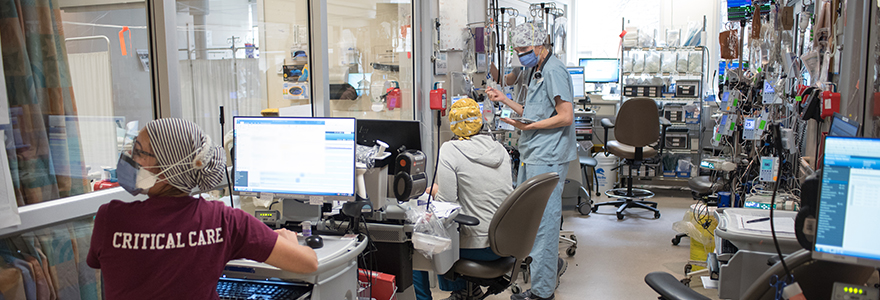Research Impact: Imaging the long-term effects of COVID-19

Sophisticated technology and key collaborations have propelled important research forward that seeks to answer questions about the devastating impact of the disease on human health
By Ashley Rabinovitch
It only took several weeks of lockdown in March 2020 for researchers at the Robarts Research Institute to shift into high gear.
“I was feeling stressed at home in March, wondering what would happen to the billion or more people who would become infected with COVID-19,” remembered Grace Párraga, PhD, the Tier 1 Canada Research Chair, Lung Imaging to Transform Outcomes and Professor, Medical Biophysics and Respirology. “I was especially worried about the long-term impact that the virus would have on survivors’ lungs.”
Since the Schulich Medicine & Dentistry alumna was recruited to join Robarts Research Institute in 2004, Párraga has worked to develop new computed tomography and magnetic resonance imaging (MRI) tools to understand the mechanisms of respiratory disease.
“We’re a biophysics and computational basic research lab that discovers ways to extract new information from pulmonary imaging, like the pathologies that drive the progression from asthma to COPD or those that predict outcomes like hospitalization,” Párraga explained.
As the first wave of COVID-19 passed, Canadians began to notice breathlessness, fatigue, uncontrollable coughing spells, and other lingering symptoms that prevented a return to normal dayto-day life for months after the onset of the infection.
In April 2020, Párraga and a large team across Ontario successfully applied for a grant from the Ontario Rapid Response program to study the longterm respiratory effects of the virus. By July, she and her team of collaborators, which includes Drs. Mike Nicholson and Inderdeep Dhaliwal, both appointed in the Division of Respirology and based next door at London Health Sciences Centre, initiated the study.
They didn’t know what to expect when they began to meet with the first of 100 patients recruited for the study, many who had low enough blood oxygen levels to be prioritized for hospitalization after the onset of infection.
“The people we’re meeting carry an enormous health burden, as well as the shame and blame of society for becoming infected, so we’re doing everything we can to give them hope for the future.”
— Grace Párraga, PhD
“We did know that people who were motivated to participate were very concerned about the symptoms they were still experiencing many weeks after the infection had subsided,” said Párraga. Using a 3.0 Tesla MRI scanner, Párraga and her collaborators are evaluating these patients’ lung structure and function at 12 weeks, six months, one year, and two years after the onset of infection.
To Párraga’s knowledge, this collaboration across Ontario is the largest of its kind anywhere in the world.
“The people we’re meeting carry an enormous health burden, as well as the shame and blame of society for becoming infected, so we’re doing everything we can to give them hope for the future,” she said.
It’s this type of interdepartmental and team-based collaboration that drives excellence in translational research — a goal in Schulich Medicine & Dentistry’s new five-year Strategic Plan.
One floor down from Párraga’s team, Robert Bartha, PhD’98, Professor, Medical Biophysics and Acting Director, Strategy and Scientific Integration at Robarts, has launched a similar study that examines the long-term neurological effects of COVID-19. Part of the Centre for Functional and Metabolic Mapping, the Bartha Lab develops highfield MRI and spectroscopy methods for early diagnosis and monitoring of treatment response, specifically related to neurological diseases like Alzheimer’s and epilepsy.
“After the onset of COVID-19, I began to think about how we could begin looking at the impact of the virus on the brain using the 7.0 Tesla (7T) human MRI scanners in our lab,” said Bartha.
“We have one of the few 7Ts in the country at Western, so we feel a responsibility to use this technology to look at the brain in a way that few people can.”
In April 2020, Bartha and a group of neurologists, imaging physicists, and infectious disease specialists secured a Western Research Catalyst Grant to conduct cognitive testing and high-field MRI scans on more than 60 patients who have experienced neurological complications from COVID-19, ranging from headaches and brain fog to the loss of smell and taste.
“Our data is only preliminary at this stage, but we’re already noticing pathological changes in the brains of COVID-19 survivors,” he noted.
“It’s a tricky study given the variation in type and length of symptoms, but we do have evidence that COVID-19 can trigger microbleeds and lesions called white matter hyperintensities in the brain,” he noted. Through the course of the next year, Bartha and his team will focus on untangling the lines of connection between post-infection neurological symptoms, cognitive function, and changes detected in the brain on MRI scans.
According to Bartha, funding opportunities like the Western Research Catalyst Grant don’t come around every day. “These are the kind of grants that get high-risk, high-reward projects off the ground,” he affirms. “We have the freedom to experiment and see what works.”
Like Párraga, Bartha draws motivation from the people who participate in his study, desperate for answers to the symptoms they thought would disappear within days or weeks.
“These people have been so grateful to find someone who acknowledges the problems they’re experiencing and searches for answers,” he said. “We will keep searching until we find the answers they’re looking for.”







